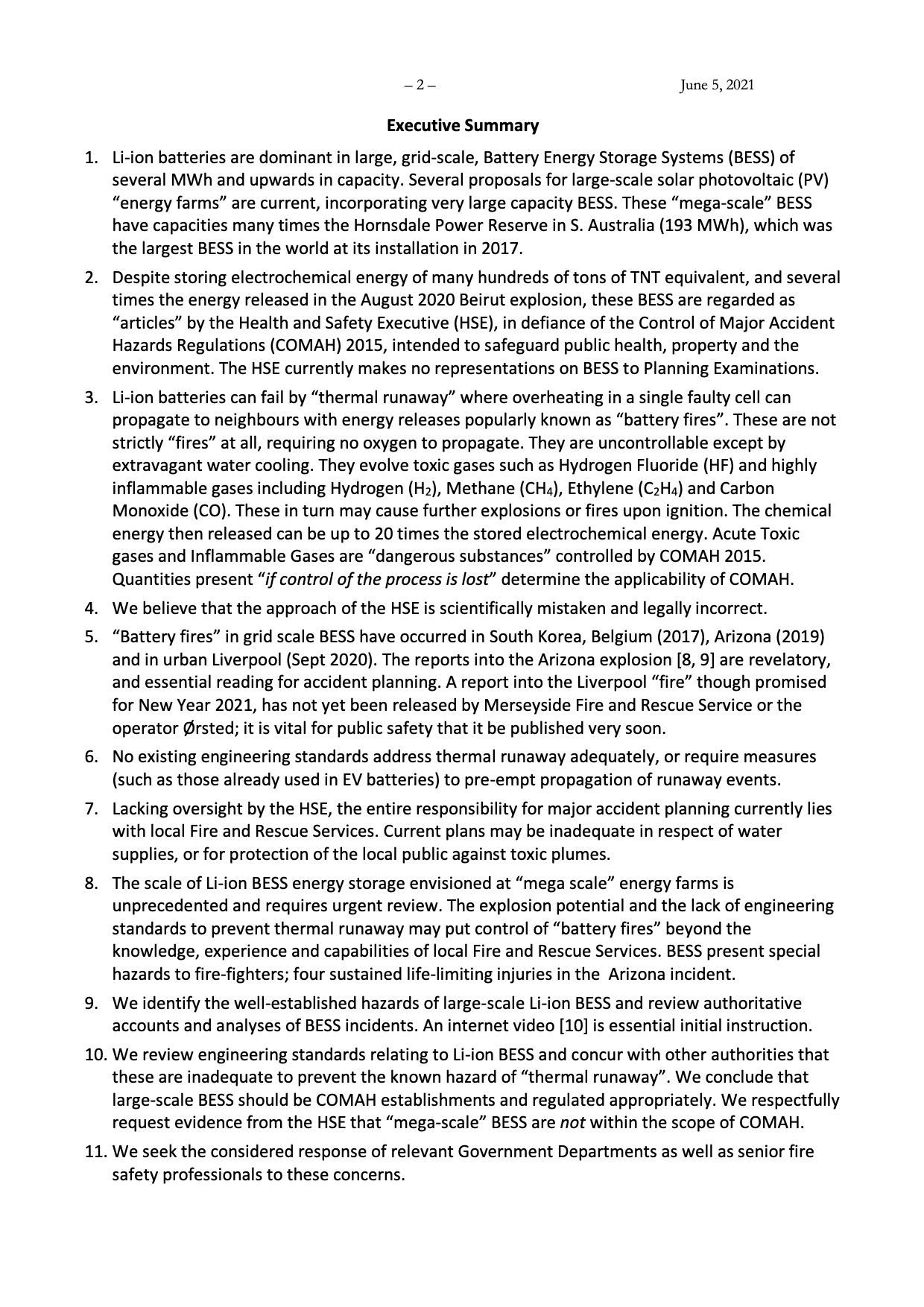Search Completed | Title | Safety of Grid Scale Lithium-ion Battery Energy Storage Systems
Original File Name Searched: EN010106-004026-DL2-Li-ion-BESS-safety-concerns_Redacted.pdf | Google It | Yahoo | Bing

Page | 003 – 2 – June 5, 2021
Executive Summary
1. Li-ion batteries are dominant in large, grid-scale, Battery Energy Storage Systems (BESS) of several MWh and upwards in capacity. Several proposals for large-scale solar photovoltaic (PV) “energy farms” are current, incorporating very large capacity BESS. These “mega-scale” BESS have capacities many times the Hornsdale Power Reserve in S. Australia (193 MWh), which was the largest BESS in the world at its installation in 2017.
2. Despite storing electrochemical energy of many hundreds of tons of TNT equivalent, and several times the energy released in the August 2020 Beirut explosion, these BESS are regarded as “articles” by the Health and Safety Executive (HSE), in defiance of the Control of Major Accident Hazards Regulations (COMAH) 2015, intended to safeguard public health, property and the environment. The HSE currently makes no representations on BESS to Planning Examinations.
3. Li-ion batteries can fail by “thermal runaway” where overheating in a single faulty cell can propagate to neighbours with energy releases popularly known as “battery fires”. These are not strictly “fires” at all, requiring no oxygen to propagate. They are uncontrollable except by extravagant water cooling. They evolve toxic gases such as Hydrogen Fluoride (HF) and highly inflammable gases including Hydrogen (H2), Methane (CH4), Ethylene (C2H4) and Carbon Monoxide (CO). These in turn may cause further explosions or fires upon ignition. The chemical energy then released can be up to 20 times the stored electrochemical energy. Acute Toxic gases and Inflammable Gases are “dangerous substances” controlled by COMAH 2015. Quantities present “if control of the process is lost” determine the applicability of COMAH.
4. We believe that the approach of the HSE is scientifically mistaken and legally incorrect.
5. “Battery fires” in grid scale BESS have occurred in South Korea, Belgium (2017), Arizona (2019) and in urban Liverpool (Sept 2020). The reports into the Arizona explosion [8, 9] are revelatory, and essential reading for accident planning. A report into the Liverpool “fire” though promised for New Year 2021, has not yet been released by Merseyside Fire and Rescue Service or the operator Ørsted; it is vital for public safety that it be published very soon.
6. No existing engineering standards address thermal runaway adequately, or require measures (such as those already used in EV batteries) to pre-empt propagation of runaway events.
7. Lacking oversight by the HSE, the entire responsibility for major accident planning currently lies with local Fire and Rescue Services. Current plans may be inadequate in respect of water supplies, or for protection of the local public against toxic plumes.
8. The scale of Li-ion BESS energy storage envisioned at “mega scale” energy farms is unprecedented and requires urgent review. The explosion potential and the lack of engineering standards to prevent thermal runaway may put control of “battery fires” beyond the knowledge, experience and capabilities of local Fire and Rescue Services. BESS present special hazards to fire-fighters; four sustained life-limiting injuries in the Arizona incident.
9. We identify the well-established hazards of large-scale Li-ion BESS and review authoritative accounts and analyses of BESS incidents. An internet video [10] is essential initial instruction.
10. We review engineering standards relating to Li-ion BESS and concur with other authorities that these are inadequate to prevent the known hazard of “thermal runaway”. We conclude that large-scale BESS should be COMAH establishments and regulated appropriately. We respectfully request evidence from the HSE that “mega-scale” BESS are not within the scope of COMAH.
11. We seek the considered response of relevant Government Departments as well as senior fire safety professionals to these concerns.
|


